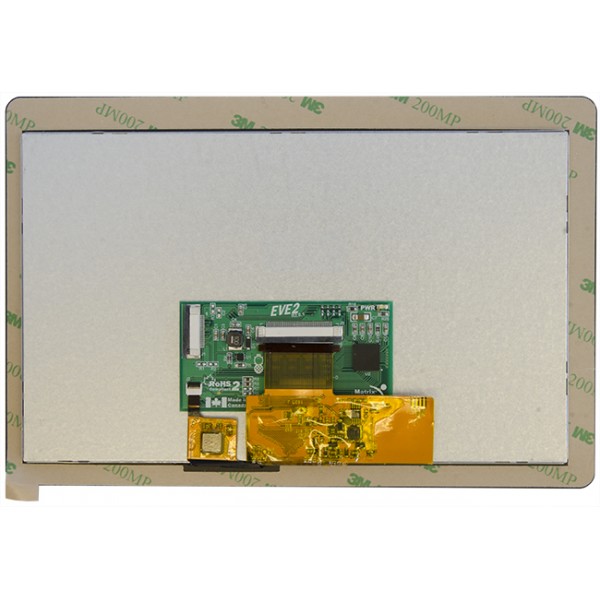Unfortunately Matrix Orbital has not released any documents so far with parameters and the EVE4x displays are not sold by distributors so I can not buy one of these yet. The timing parameters for the EVE4-101 and EVE4-40 are from their software.
That said, I find the parameters you received for the EVE4x-70G a bit odd. Which does not mean that these are wrong but the other 1024x600 panels I have in my spreadsheet have other parameters. One value that is particulary odd in this set is PCLK = 1 though. For the BT817/BT818 this has a special meaning, this enables the second PLL - EXTSYNC. Without setting this up and the 4.x branch definately does not do that, REG_PCLK_FREQ has the default value of 60MHz which should result in 62 frames per second. This may explain the other timing values, maybe they went back from this default value of 60MHz and adapted the values to get as close as possible to 60 FPS. Instead of using the timing values for the panel and adjusting the frequency.
A configuration based on the timing values given for the 5.x branch could be this:
if defined (EVE_EVE4_70G)
define EVE_HSIZE (1024L)
define EVE_VSIZE (600L)
define EVE_VSYNC0 (13L)
define EVE_VSYNC1 (20L)
define EVE_VOFFSET (16L)
define EVE_VCYCLE (768L)
define EVE_HSYNC0 (37L)
define EVE_HSYNC1 (40L)
define EVE_HOFFSET (85L)
define EVE_HCYCLE (1259L)
define EVE_PCLK (1L) / 1 = use second PLL for pixel-clock in BT817 / BT818 /
define EVE_PCLK_FREQ (59000000L) / 59MHz - value for EVE_cmd_pclkfreq -> 61 FPS /
define EVE_PCLKPOL (0L)
define EVE_SWIZZLE (0L)
define EVE_CSPREAD (0L)
define EVE_TOUCH_RZTHRESH (1200L)
define EVE_HAS_CRYSTAL
define EVE_GEN 4
define EVE_HAS_GT911
endif
So pretty much the same. Regarding the GT911 I can only guess as I do not have data if the EVE4 actually are still using these.
I believe I have seen the panel without the BT81x board at the Matrix Orbital website, if I find it I'll have a look at the timing parameters.
You could of course use the 4.x branch but it does not support the newer commands and registers, as few as these are. And it is slower.


Hello! I'm testing out one of the pre-production 7.0" IPS 1024x600 EVE4 displays from Matrix Orbital, but am having a bit of trouble getting it to function correctly with this library.
The symptoms are that an image displays, but the whole screen has an intermittent flicker, sometimes with a position offset, as well as some vertical streaking primarily on the left edge (which appears as horizontal streaking on the top edge in my application, as I'm using rotation 2 for portrait orientation). Touch appears to work OK for buttons, but none of the sliders are functional. After a period of time (a minute or so), the display will go dark until power cycled. If the code execution is interrupted, such as when the microprocessor is being re-programmed, the display (in its frozen state) is visually 100% stable, so it appears as though the glitching only happens while the display is actively being updated.
Being brand new, there wasn't a definition for this display in EVE_config.h, so I requested the timing parameters from Matrix Orbital and created my own. I've never done this before, so I wouldn't be surprised if I made a mistake at this step, or misinterpreted the mapping of the timings for how this library expects them.
The timing values I received from Matrix Orbital:
And then my resulting configuration:
As you can probably tell from those defines, I'm still on the 4.x branch from the end of last year. If supporting this display requires an upgrade to the 5.x branch I can do that, I'm just trying to not change too many things at once if I can avoid it.
Thanks in advance for the help!